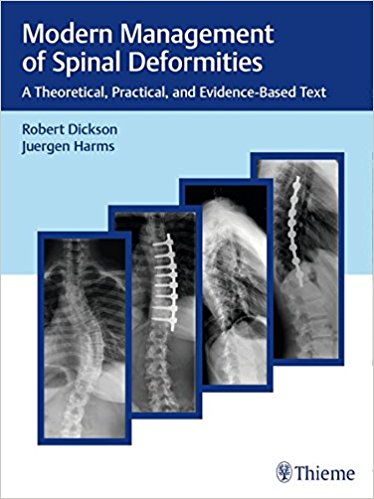
Authored by two world-renowned pioneers in the field of spinal surgery, Modern Management of Spinal Deformities: A
Theoretical, Practical, and Evidence-Based Text covers the range of spinal deformities-emphasizing scoliosis-and their
etiologies, including idiopathic, congenital, neuromuscular, tumors, neurofibromatosis, and more.
All too often in other works, too much attention has been focused on how to put in metalwork, without sufficiently
discussing the what, when, and why. Authors Dickson and Harms provide a wealth of knowledge through experience that
shows how important newer therapeutic concepts and surgical methods are, such that beyond just preventing the
progression of deformity, it is now possible, with correctly performed surgery, to eliminate deformity and straighten
spines permanently.
Features
providing the basis for good practice
Spine surgeons, whether orthopaedically or neurosurgically trained, will value this authoritative treatise on spinal
deformities.
1. The Beginnings of Surgery for Spinal Deformities
1.1 The Early Days
1.2 Posterior Instrumentation
1.3 Anterior Instrumentation
References
2. Basic Principles
2.1 Definitions and Terminology
2.1.1 Planes and Deformities
2.1.2 Nonstructural and Structural Deformities
2.2 Curve Characteristics
2.2.1 Named Vertebrae
2.2.2 Curve Size
2.2.3 Vertebral Rotation
2.2.4 Curve Patterns
2.3 Spinal Growth
2.3.1 Indices of Maturity
2.3.2 Measurement of Bone Age
2.3.3 Centile Charts
2.4 Classification of Spinal Deformities
2.5 Primary, Progressive, or Structural Deformities
2.5.1 Idiopathic Deformities
2.5.2 Congenital Deformities
2.5.3 Neuromuscular Deformities
2.5.4 Deformities due to Neurofibromatosis
2.5.5 Miscellaneous Conditions Associated with Spine Deformities
2.5.6 Miscellaneous Conditions in which a Spinal Deformity Is Common
2.6 Secondary, Nonprogressive or Nonstructural Deformities
2.6.1 Pelvic Tilt Scoliosis
2.6.2 Irritative Lesions
2.6.3 Hysterical Scoliosis
References
3. The Etiology of Spinal Deformities
3.1 Introduction
3.2 The Development of Idiopathic Scoliosis
3.3 Experimental Models
3.4 What Pathogenesis Tells Us about Treatment
3.4.1 Surgical Treatment of Spinal Deformities
References
4. Idiopathic Scoliosis
4.1 Epidemiology of Late-Onset Idiopathic Scoliosis
4.1.1 Scoliosis in the Community
4.2 Screening for Scoliosis
4.2.1 Definitions and Criteria
4.2.2 Natural History
4.3 Late-Onset Idiopathic Scoliosis
4.3.1 Clinical Presentation and Evaluation
4.3.2 Classification
4.3.3 Treatment
4.3.4 Radiological Evaluation
4.3.5 Specific Curve Patterns
4.4 The Adolescent with the Bigger Curve
4.4.1 Intraoperative Traction
4.4.2 Anterior Multiple Diskectomy
4.5 Osteotomies
4.5.1 Smith-Peterson Osteotomy
4.5.2 Ponte Osteotomies
4.5.3 Pedicle Subtraction Osteotomy
4.5.4 Apical Vertebral Resection
4.6 Early-Onset Idiopathic Scoliosis
4.6.1 Clinical Features
4.6.2 EDF Cast Treatment
4.6.3 Operative Treatment
4.6.4 Other Methods of Growth Modulation
Case Gallery
Case 1: The Value of Anterior Multiple Diskectomy
Case 2: Anterior Instrumentation Only; Lenke1AR
Case 3: Anterior Instrumentation Only; Lenke1b
Case 4: Anterior Instrumentation Only; Lenke1b
Case 5: Posterior Instrumentation Only; King 4, Lenke 1
Case 6: Posterior Instrumentation Only; Lenke1c
Case 7: Combined-Anterior Diskectomy Then Posterior Instrumentation; Lenke 1AL
Case 8: Combined-Anterior Diskectomy Then Posterior Instrumentation; Lenke 1AL
Case 9: Thoracolumbar/Lumbar; Single Lenke 5
Case 10: Double Curves; Lenke 6
Case 11: Double Thoracic/Lumbar; Lenke 3
Case 12
References
5. Scheuermann's Disease
5.1 Pathogenesis
5.2 Clinical Diagnosis
5.3 Radiological Diagnosis
5.4 Management
5.4.1 Conservative Treatment
5.4.2 Surgical Treatment
References
더보기
6. Congenital Deformities
6.1 Etiology of Congenital Spine Anomalies
6.1.1 Normal Development of Axial Structures
6.1.2 Theories of the Developmental Basis of Deformities
6.1.3 The Pathogenesis of Congenital Vertebral Malformations
6.2 The Clinical Spectrum of Deformity
6.3 Congenital Bone Anomalies
6.3.1 Congenital Scoliosis
6.4 Practice Point
6.4.1 Preoperative
6.4.2 Surgical Technique
6.5 Congenital Kyphosis
6.5.1 Natural History
6.5.2 Congenital Cord Deformities
6.6 Congenital Lordosis
6.7 Spinal Dysraphism
6.7.1 Tethered Conus
6.8 Congenital Spinal Deformity Syndromes
6.8.1 Klippel-Feil Syndrome
6.8.2 VACTERL Association
6.8.3 Thoracic Insufficiency Syndrome
6.8.4 Conditions Associated with Congenital Spine Deformities
Case Gallery
Case 1: Multiple Hemivertebrae's1, T8, T11
Case 2: Hemivertebrae Plus Contralateral Bar
Case 3: Lower Lumbar/Lumbosacral Anomalies
Case 4: Thoracic Meningocele
References


